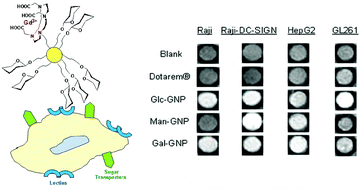Sugar/gadolinium-loaded gold nanoparticles for labelling and imaging cells by magnetic resonance imaging†
Abstract
Targeted magnetic resonance imaging (MRI) probes for selective cell

* Corresponding authors
a
Laboratory of Glyconanotechnology, Biofunctional Nanomaterials Unit, CIC biomaGUNE, P° Miramón 182, 20009 San Sebastián, Spain
E-mail:
spenades@cicbiomagune.es
Fax: +34 943 00 53 35
Tel: +34 943 00 53 07
b Biomedical Research Networking Center in Bioengineering, Biomaterials and Nanomedicine (CIBER-BBN), P° Miramón 182, 20009 San Sebastián, Spain
c Molecular Imaging Unit, CIC biomaGUNE, P° de Miramón 182, 20009 San Sebastián, Spain
Targeted magnetic resonance imaging (MRI) probes for selective cell

 Please wait while we load your content...
Something went wrong. Try again?
Please wait while we load your content...
Something went wrong. Try again?
A. Irure, M. Marradi, B. Arnáiz, N. Genicio, D. Padro and S. Penadés, Biomater. Sci., 2013, 1, 658 DOI: 10.1039/C3BM60032G
To request permission to reproduce material from this article, please go to the Copyright Clearance Center request page.
If you are an author contributing to an RSC publication, you do not need to request permission provided correct acknowledgement is given.
If you are the author of this article, you do not need to request permission to reproduce figures and diagrams provided correct acknowledgement is given. If you want to reproduce the whole article in a third-party publication (excluding your thesis/dissertation for which permission is not required) please go to the Copyright Clearance Center request page.
Read more about how to correctly acknowledge RSC content.
 Fetching data from CrossRef.
Fetching data from CrossRef.
This may take some time to load.
Loading related content
